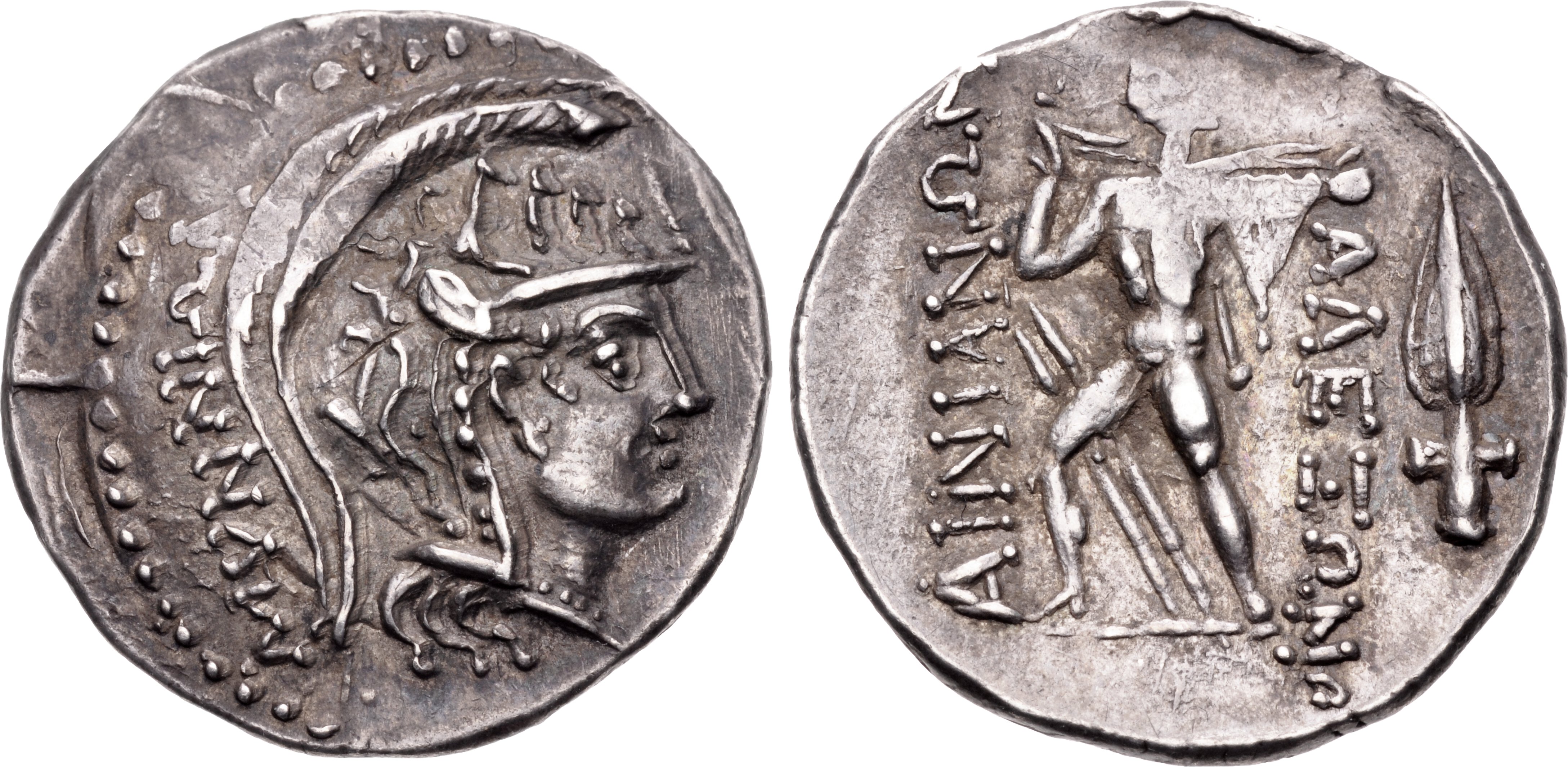S 1440 - Hypata (Ainianes), silver, didrachms (87-84 BCE)
From SILVER
87 BCE - 84 BCE Silver 5,677 kg
Description
| ObverseInscription or printing placed on the obverse.: | MVNNIΩN to left (Greek).Helmeted head of Athena right |
| ReverseInscription or printing placed on the reverse.: | ΑΙΝΙΑΝΩΝ (Greek).The hero Phemios, wearing scabbard with sword, standing left, head right, shooting sling to right, AΛEΞΩN and spearhead to right |
Mint and issuing power
| MintIdentifies the place of manufacture or issue of a numismatic object.: | Hypata | Ancient regionAncient region.: | Thessaly | Modern countryModern country: Greece | AuthorityIdentifies the issuing power. The authority can be "pretended" when the name or the portrait of X is on the coin but he/she was not the issuing power. It can also be "uncertain" when there is no mention of X on the coin but he/she was the issuing power according to the historical sources: | Ainianes, Roman Republic |
Chronology
| FromIdentifies the initial date in a range assigned in a numismatic context. | 87 BCE | toIdentifies the final date in a range assigned in a numismatic context.. | 84 BCE | PeriodTime period of the numismatic object.: Hellenistic 323-30 BC |
Physical description
| MetalThe physical material (usually metal) from which an object is made.: | Silver |
Median weightMedian of the weights of numismatic objects (in grams). in grams | 7.60 | DenominationTerm indicating the value of a numismatic object. Examples: tetradrachm, chalkous, denarius.: | didrachm |
StandardStandard.: |
Image

S1440 Ainianes.jpg [1]
References
| Die study referencePublication of the study: | Callataÿ 2004a1Callataÿ 2004a | ||
| Coin series referenceReference to coin series study: | Sear I2Sear I, n° 2057, HGC 43HGC 4, n° 41 | ||
| Coin series web referenceCoin series web references: | |||
Obverse dies distribution
| FrequencyFrequency of specimen in distribution. ᵖ | Number of obversesNumber of obverse dies. ᵖ (o) | % (o) | Number of coinsNumber of coins. (n) | % (n) | Die nameName(s) of the die(s). |
| 1 | 12 | 42.86 | 12 | 15.79 | A3, A6, A9, A10, A11, A16, A17, A19, B2, B5, B6, B7 |
| 2 | 10 | 35.71 | 20 | 26.32 | A4, A7, A14, A15, A18, B1, B3, B4, B8, B9 |
| 3 | 4 | 14.29 | 12 | 15.79 | A5, A8, A12, A13 |
| 7 | 1 | 3.57 | 7 | 9.21 | A1 |
| 25 | 1 | 3.57 | 25 | 32.89 | A2 |
| Total | 28 of 28 | 100 | 76 of 76 | 100 |
Reverse dies distribution
no distribution is available
Quantification
| Number of obversesNumber of obverse dies. ᵖ (o) | 28 | Number of singletons (o1)The number of singleton coins. ᵖ | 12 |
| Number of reverse diesNumber of reverse dies. (r) | 60 | Number of coinsNumber of coins. (n) | 76 |
| Coins per obverse dieNumber of coins per obverse die. (n/o) | 2.71 | Coins per reverse dieNumber of coins per reverse die. (n/r) | 1.27 |
| Reverse per obverse ratioRatio of obverse dies divided by reverse dies. (r/o) | 2.14 | Percentage of singletons (o1)number of coins (n) divided by the number of singletons (o1) ᵖ | 42.86 % |
| Original number of dies (O) (Carter 1983 formula)The estimation of the number of coins according to Carter 1983 ᵖ | 37.35 | Coins struck if 20,000 as average productivity per dieCoins made if the average productivity for obverses (according to Carter) is 20,000. ᵖ | 747,000 |
| Original number of dies (O) (Esty 2011 formula)The estimation of the number of coins according to the singleton formula in Esty 2011 ᵖ (O) | 44.33 | Survival rate if 20,000 as average productivity per dieSurvival rate if average productivity is 20,000. ᵖ | 0.00010 |
| Coverage (o = % of O) (Esty 1984 formula)Esty 1984 - coverage (% of O) ᵖ (o = % of O) | 84.21% | Die productivity if survival rate 1/2,000Average productivity if survival rate is 1/2,000. ᵖ | 4,069.61 |
| Weight of silver (in kg) if 20,000 coins per die (O = Carter formula)Carter 1983 * Median weight * 20000 (*10 if gold or electrum) ᵖ | 5,677 kg <br /> 5,677 kg | Die productivity if survival rate 1/5,000Average productivity if survival rate is 1/5,000. ᵖ | 10,174.03 |
Remarks